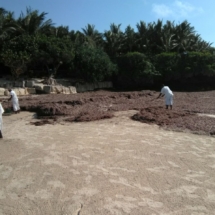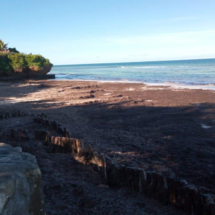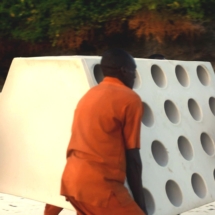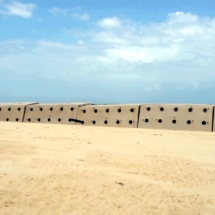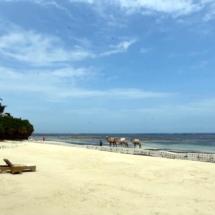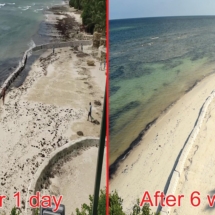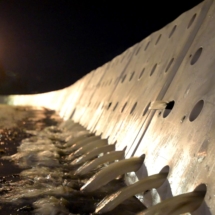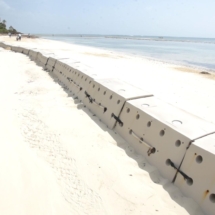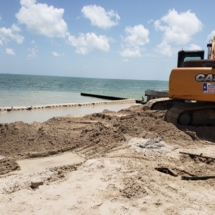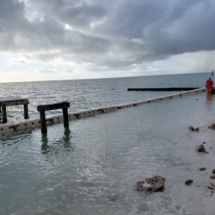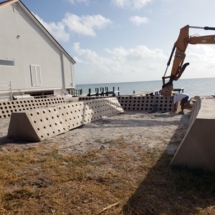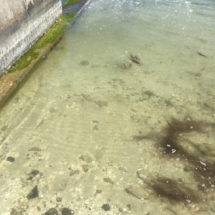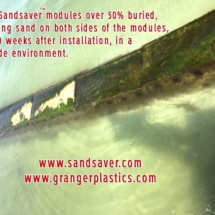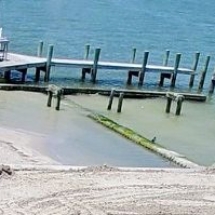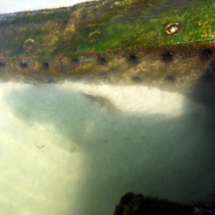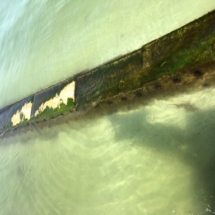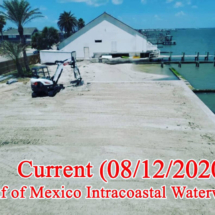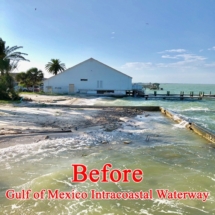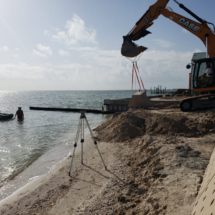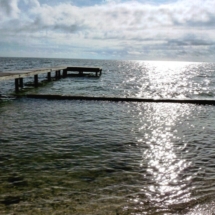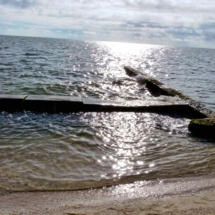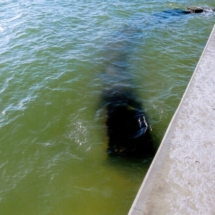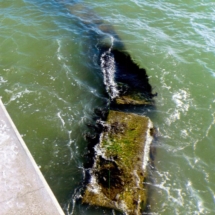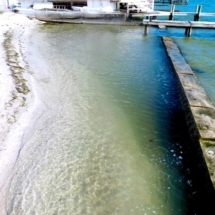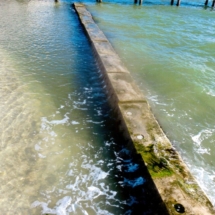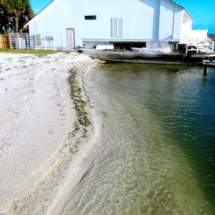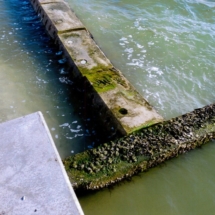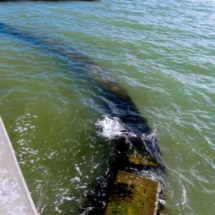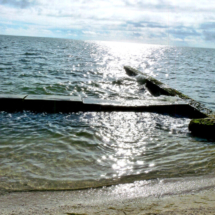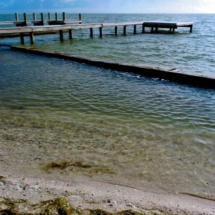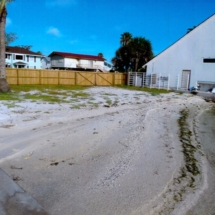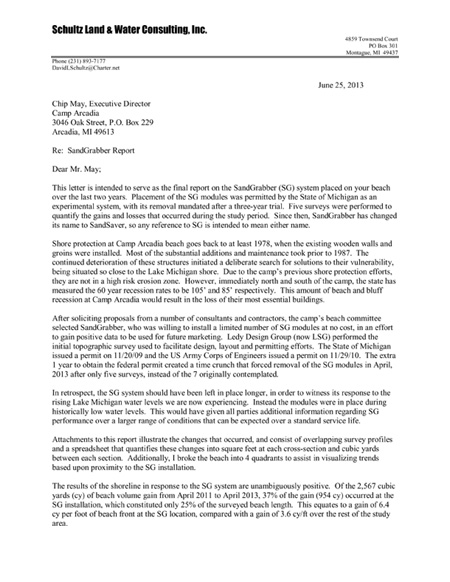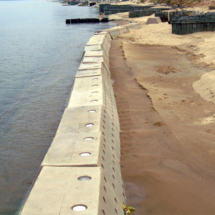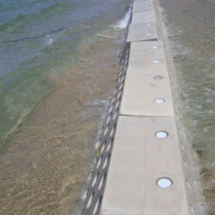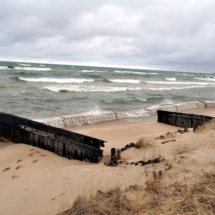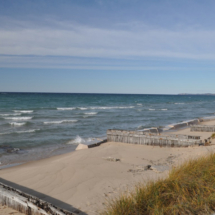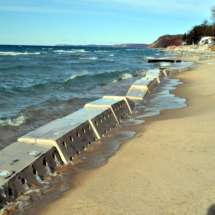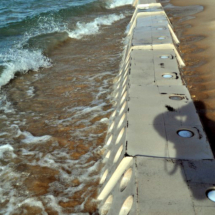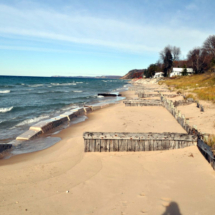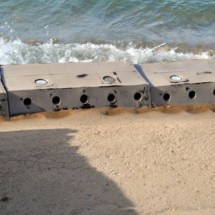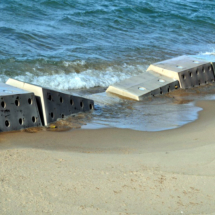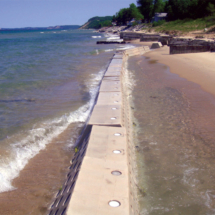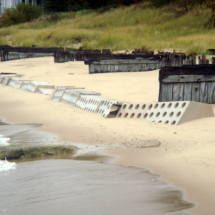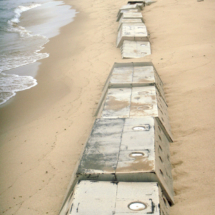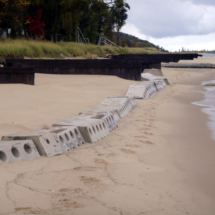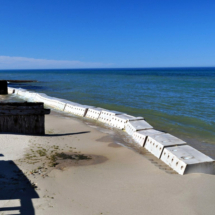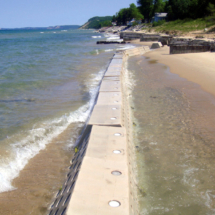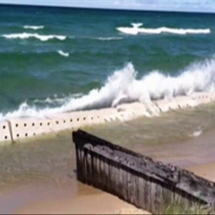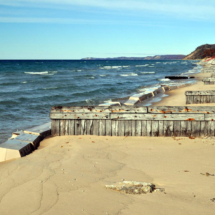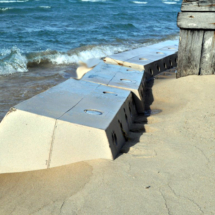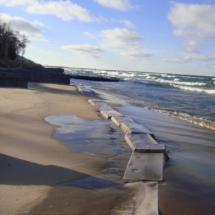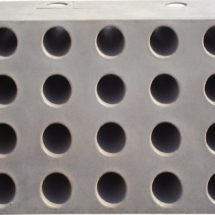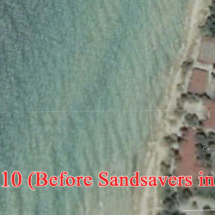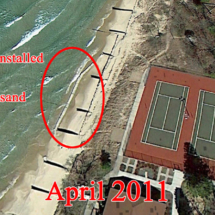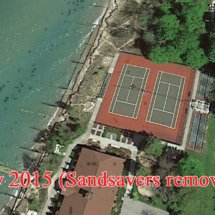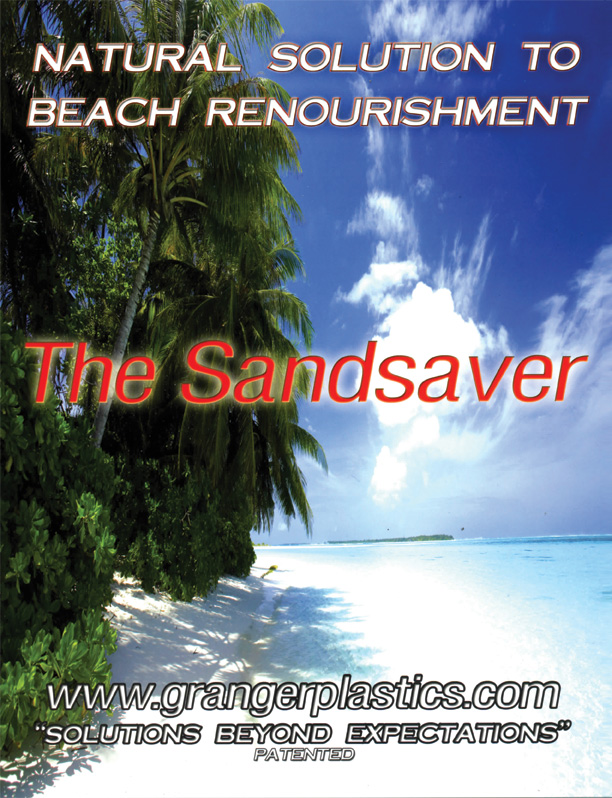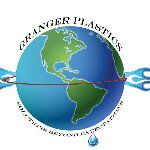Sandsaver Beach Erosion Solution
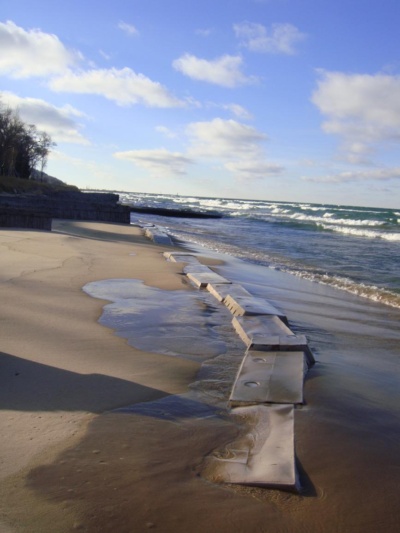
Sandsaver near being completely covered by sand
Beach erosion continues to plague coastal communities all over the globe. Increasing costs along with limited, temporary results for previously accepted historical re-nourishment methods such as beach dredging, coastal armoring, sea walls, groynes and jettys have many coastal property owners and organizations looking for a natural, long term solution to beach erosion issues.
The Sandsaver™, a rotationally molded beach erosion barrier is quickly becoming one of the most sought out beach restoration methods. The Sandsaver™ provides a natural solution to beach erosion by breaking down the energy of the wave as the surf comes into the beach, as the wave crashes against the front of the Sandsaver modules. Once the wave energy is broken down as it crashes against the beach erosion barrier, the water activity carries the sand & sediment thru the larger openings on the surf side of the module, where it speeds through the tapered smaller openings on the beach side of the module, allowing the sand time to settle on the beach side of the module as the water retreats back into the surf.
Using basic conservative calculations, the Sandsaver re-builds beachfront property through a natural means of beach renourishment, using the wave energy, activity and sand contents of the water at a fraction of the cost of other traditionally accepted methods such as dredging, groynes, jettys or coastal armoring.
The modular sandsaver system can be used on a temporary basis, putting the modules in place, allowing them to re-build the beach and either moving them forward into the surf in effort to build additional width profile to the beach, leave them in place to provide a long term solution or remove them, allowing for nature to run its course and putting them back once the beachfront property becomes eroded once again.
The Sandsaver™ has been proven successful in multiple beach restoration projects in Lake Michigan, Gulf of Mexico and the Indian Ocean. With the proven successes across multiple coastal regions, the Sandsaver continues to garner immense international interest as a viable replacement to traditional, less effective methods, such as dredging, re-nourishment and other hardened structures such as coastal armoring, sea walls and more.
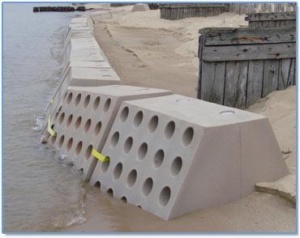 | 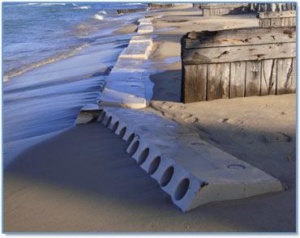 |
Sandsaver: A Closer Look
The video above tells about the general concept of how Sandsaver works and about Granger Plastics Company, the rotational molding company who owns the patents and trademarks on Sandsaver.
The Sandsaver™ is based on previously proven innovative technology dating from the late 1960’s and 1970’s called “The Sandgrabber”; Sandgrabber was successfully used in a number of installations including Hawaii, Massachusetts and even as recently as the 1990’s in Louisiana.
The pictures below are from a Sandgrabber installation from Canada’s Wheatley Province Park installation. Notice in the picture on the left the special Sandgrabber cinder blocks being installed and in the picture on the right, how much sand the system had accumulated already by day 50. By the looks of the images, the beach erosion has been reversed and the sand has almost completely covered the Sandgrabber system.
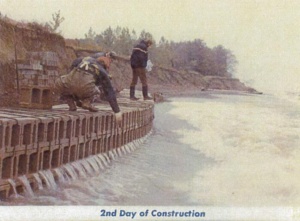 | 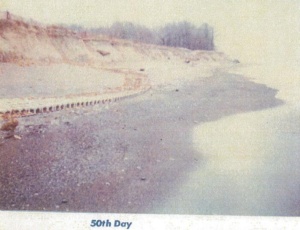 |
How Sandsaver Works
See an brief explanation how the Sandsaver beach erosion solution system works in the video clip above. Sandsaver operates in 2 ways. First, the Sandsaver’s durable rotationally molded construction allows for the wave to crash against the module, breaking down the energy of the wave, immediately reducing the potential erosion. Second, the larger opening of the tapered through holes on the Sandsaver modules allow for the sand to travel into the larger opening of the tapered holes, eventually speeding up and settling out on the beach side of the module where the sand particles continue to accumulate until the module is completely covered from both behind and in front of the Sandsaver modules. When the tide retreats it has to pass back through the smaller of the tapered holes, allowing the sand time to settle onto the beach and not back into the surf. Eventually the modules will become completely covered in accumulated sand.
The modular construction of the units allow for easy installation and easy removal of the units, which allows for the units to be used in various locations, multiple times or simply left as a permanent installation. The extremely durable rotational molding construction provides a nearly indestructible unit, when properly filled with concrete will weigh approximately 5200 pounds.
Sandsaver Features
- Sandsaver is the only modular system, that promotes beach accretion, while preventing beach erosion.
- Rotationally Molded from nearly indestructible, Food Grade Polyethylene.
- Modular design for simple installation, no chains or rebar required.
- Inexpensive and re-usable in comparison to alternative/currently accepted beach restoration methods.
- Sandsaver is molded from Polyethylene, which is 100% recyclable.
- Sandsaver, drastically reduces the carbon footprint of most Beach Restoration projects, by not requiring numerous, gas guzzling Barges.
- Sandsaver, can be re-used multiple times, for multiple installs, in multiple locations, if so desired. Or the system can be left in place permanently.
- Environmentally friendly, will not deteriorate, nor will the units & “take in” any Sea Turtles or other living organisms, unlike any type of Dredging barges.
- Each module weighs approximately 5200 pounds when full; Not light weight or easily moved; Tornados/Hurricanes would have to have unheard of speeds to move a module due to the weight. Contingent upon the length of the installation, the weight of the system increases drastically.
- Tapered through holes with larger opening exposed closest to surf, for easier transport to beach side of module.
- Will not leave exposed concrete, rocks, wood, or other materials that could be potentially dangerous to those utilizing the beach, alleviating those safety concerns.
- Modular system allows for as much or as little Beach re-nourishment as needed.
- Protected by US and International Patents
- Proudly manufactured in the United States of America.
Sandsaver Installs
Indian Ocean- Diani Beach, Kenya
In January of 2020, Granger Plastics Company assisted in a Sandsaver beach erosion solution installation at the beautiful, 5 star Swahili Beach Resort in Diani Beach, Kenya. The opulent resort had been experiencing severe beach erosion over the last few years and decided to install Sandsaver in effort to combat their beach erosion issues. Take a look at the video and pictures below to see the incredible accumulation of sand being realized at the resort, as the width profiles have increased over 100 feet in some areas while accreting over 20,000 cubic yards of sand in just 6 weeks time, effectively renourishing the beautiful ocean-front property on the Indian Ocean.
Beach Erosion Solution Install: Indian Ocean Part 1
In the video above, watch as the Sandsaver beach erosion barriers are installed by crews of manual labor, put into place, filled with sand and then see how the units accumulate over 3,000 cubic yards of sand and increasing the width profile of the resort’s beach as much as 75 feet in some areas in just 2 short weeks!
Beach Erosion Solution Install: Indian Ocean Part 2
Watch the second part of the video series showing the Sandsaver Diani Beach, Kenya installation, where the units continue to perform exceptionally well, accumulating over 20,000 cubic yards of sand while building up the width profile over 100 feet in areas of the beach in just 6 short weeks!
Beach Erosion Solution Install: Indian Ocean Part 3
Watch in the third part of the Indian Ocean Beach Erosion Solution video series as the Sandsaver continues to provide obviously positive results of sand growth and increased width profile of the beach and adjacent properties, North and South of the installation location. In this first update since the Covid-19 lockdown of 2020 that has plagued the globe, we see that the system continues to accumulate sand on both sides of the beach erosion barriers. Sand accumulation since the Sandsaver installation exceed 30,000 cubic yards of sand according to extremely conservative estimates. The width profile of the beach has grown over 150 feet already in some areas of the beach, as the beach erosion solution continues to prove itself as a dredging alternative. It will only be a matter of time before the Sandsaver modules are completely covered by the sand accumulation.
Sandsaver Diani Beach, Kenya Photo Gallery
Click any of the Sandsaver Diani Beach, Kenya Images Below for them to open in a larger lightbox gallery
Gulf of Mexico Sandsaver Install
In the late summer of 2019, a private property owner selected the Sandsaver™ to resolve their property’s beach erosion issues. This property was on an inter-coastal water-way on the Gulf of Mexico. The property owner installed Sandsaver™ across the entire width of the beach front property in effort to rebuild the beach. Because of the installation location, the tide experienced at the property is on average, less than 12 inches in height. Initially, the lack of tide caused great concern as to Sandsaver’s ability to rebuild the beach, however in less than 10 weeks in the reduced tide environment, the Sandsaver™ modules performed extremely well and were already near 50% covered! See the photos below of the Sandsaver™ Gulf of Mexico installation.
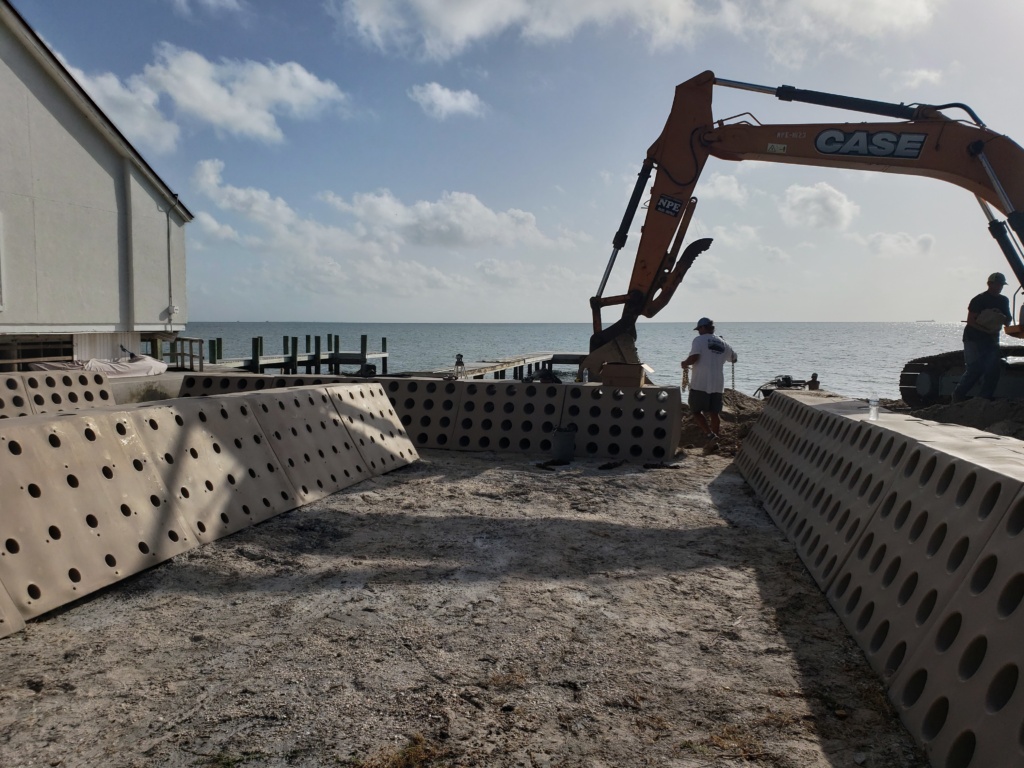
Sandsaver being filled with concrete prior to installation
Each Sandsaver module was filled with 1 yard of concrete and put into position, utilizing heavy equipment, straps and manual labor. While the strength of the current was not the driving force as it has been in previous Sandsaver installations, the concrete was necessary in this particular instance due to the regular storm and hurricane threat occurrences.
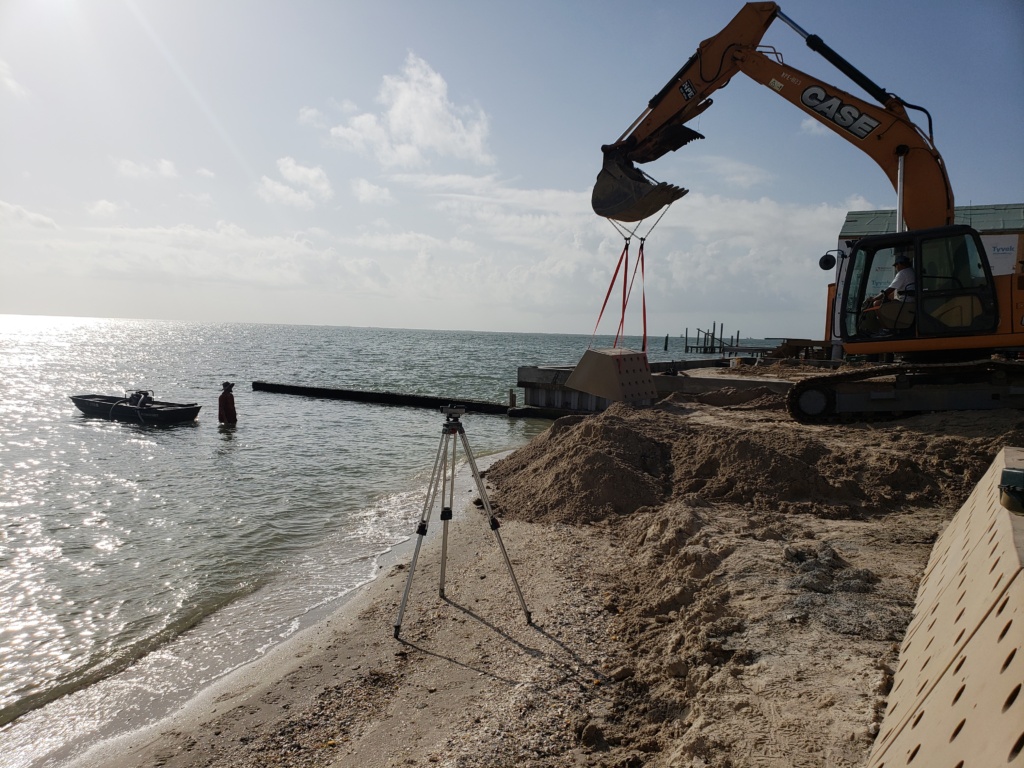
Sandsaver being installed in the Gulf of Mexico

Because of the intracoastal waterway location with such small surf, the Sandsaver units were installed in a different orientation than most installs in effort to maximize the sand accumulation on the beach side of the modules. Within just a matter of weeks after installation, the modules were starting to show signs of being near 50% buried, showing sand accumulation on both sides of the modules being installed in a low-tide environment.
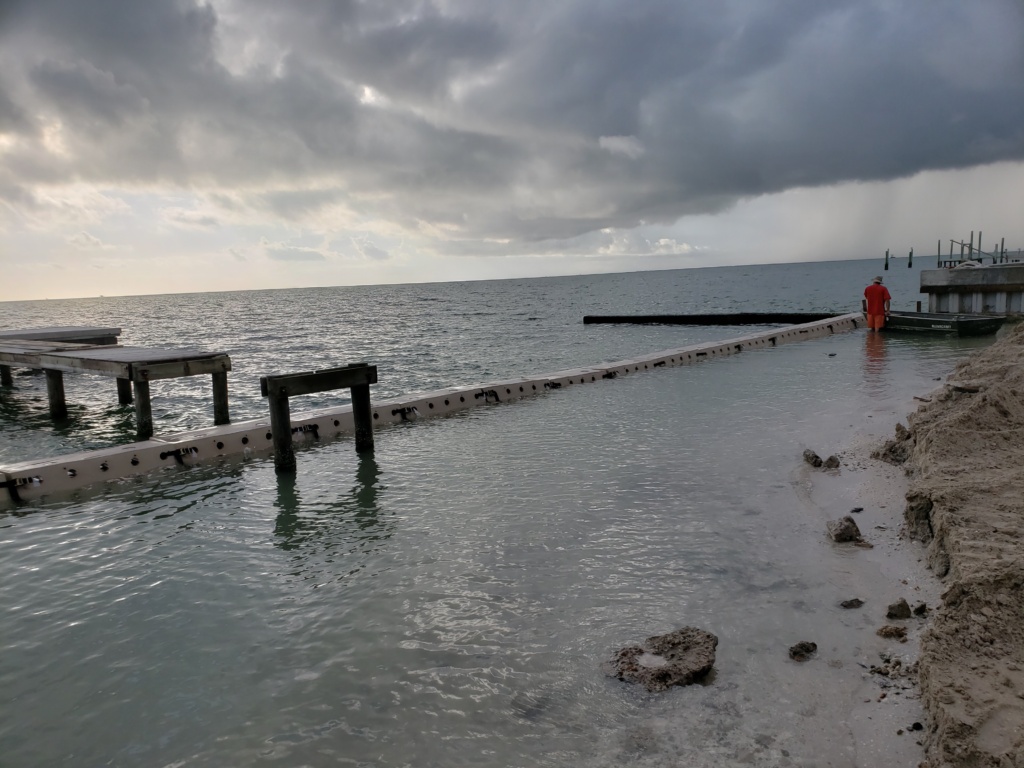
Sandsaver installed in an intra-coastal waterway in the Gulf of Mexico
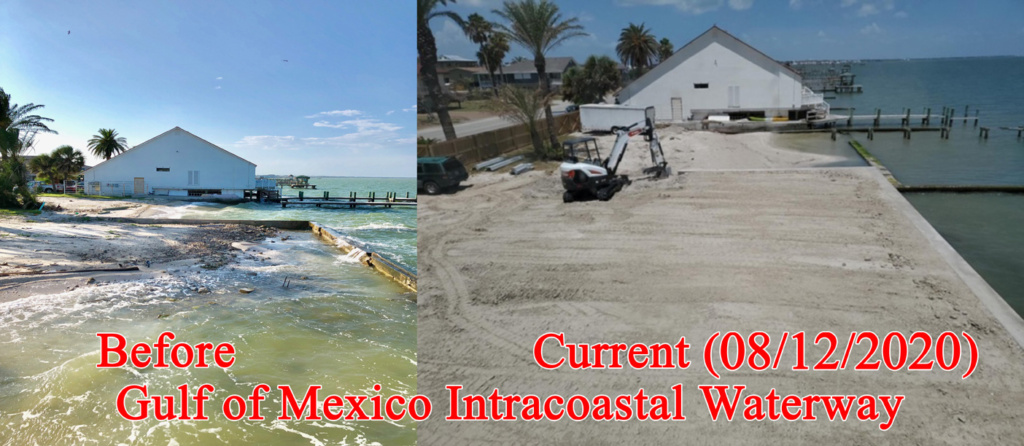
Sandsaver before and after in Gulf of Mexico intra-coastal waterway
Each Sandsaver module was filled with 1 yard of concrete and put into position, utilizing heavy equipment, straps and manual labor. While the strength of the current was not the driving force as it has been in previous Sandsaver installations, the concrete was necessary in this particular instance due to the regular storm and hurricane threat occurrences.
Sandsaver Gulf of Mexico Photo Gallery
Click any of the Sandsaver Gulf of Mexico Images Below for them to open in a larger lightbox gallery
Lake Michigan Sandsaver Install
In the summer of 2011, Sandsaver was installed in Lake Michigan as a Pilot US installation to prove its effectiveness as a natural solution to beach erosion inside one of the Great Lakes. A 250 foot system was installed in effort to rebuild beach front property for a church camp in Michigan. Pre-installation surveys were conducted in effort to gauge the systems ability to accrete sand and to study the effects the system would have an adjacent properties. A third-party engineering firm conducted a number of surveys and a final survey, with a final report stating that “the results of the shoreline in response to the Sandsaver system are unambiguously positive.”
The third-party engineering report and course of surveys also discovered and reported that “at the very least, the Sandsaver design did not generate adjacent negative impacts associated with shore-normal and impermeable structures. The Sandsaver modules permeability and placement in a shore-parallel orientation demonstrated no negative impacts to adjacent stretches of beaches.”
The state of Michigan authorized the licenses for the Lake Michigan installation quickly with little to no concerns for the installation to continue as initially scheduled. For reasons unknown, the permits at the Federal level took nearly a year for authorization, which consumed time that was allotted for install, reducing the complete number of land surveys from 5 to the initial 7 that were ordered. The decrease in service time by 33% naturally lowered the total outcomes throughout a duration of traditionally low tide levels, nevertheless the system was capable to generate unambiguously favorable outcomes as demonstrated by the information provided by the third party engineering firm conducting the research studies and the report.
The state of Michigan authorized the licenses for the Lake Michigan installation quickly with little to no concerns for the installation to continue as initially scheduled. For reasons unknown, the permits at the Federal level took nearly a year for authorization, which consumed time that was allotted for install, reducing the complete number of land surveys from 5 to the initial 7 that were ordered. The decrease in service time by 33% naturally lowered the total outcomes throughout a duration of historically low water levels, nevertheless the system was capable to generate unambiguously favorable outcomes as demonstrated by the information provided by the third party engineering firm conducting the research studies and the report.
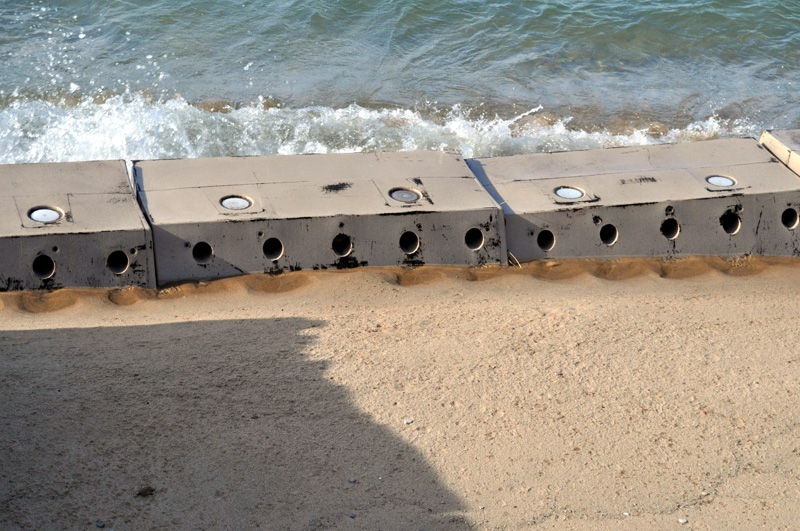
Sandsaver Lake Michigan: Before, During and After
See the images below from Google Earth, showing the Lake Michigan beach front property before the Sandsaver beach erosion solution was installed, notice the badly eroding beach and the vulnerably exposed coastline, as the Lake Michigan surf threatens to impede upon the land and structures.
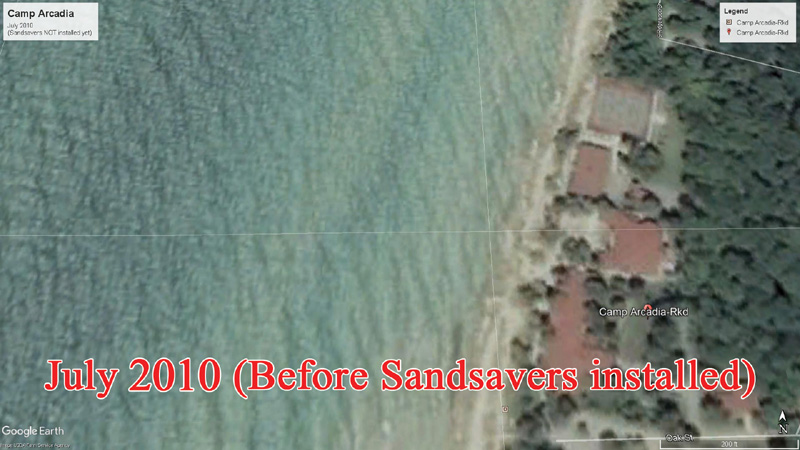
Before Sandsaver was installed on Lake Michigan July 2010
Once the Sandsavers were installed, the sand accumulation became quickly noticeable, as the Sandsaver™ units quickly showed signs of accreting sand on both the beach and surf side of the modules. As you can see in the image below, the Sandsavers drastically increased and improved the width profile of the beach along with the overall slope of the beach drastically, as sand continues to accumulate on the beach side of the Sandsaver beach erosion barriers. You can visibly notice the increased sand content at the location in comparison to the pictures above and below of before the Sandsavers were installed (above) and after the Sandsavers were removed.
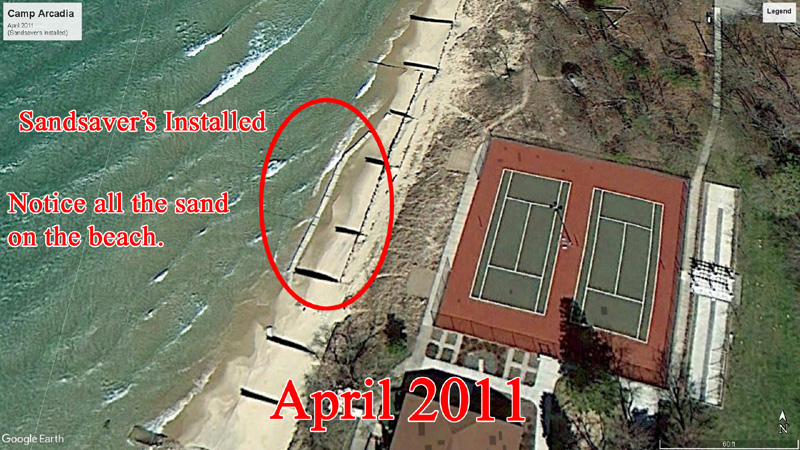
Sandsaver Beach Erosion Barriers Saving a Lake Michigan Beach
Since the pilot installation period was reduced by 1 year due to the USACE consuming an additional year to provide the federal level permits, the system was only installed for 66% of the originally planned duration. This was unfortunate as the additional year could have provided even better than realized results and offered greater protection to the shores of the church champ and also shown how well the system would have performed during a period of increasing or high water levels.
The picture below shows the Lake Michigan location after the Sandsaver’s permitted installation time came to an end and the units had to be removed. You can see after the units were removed, the erosion continued and eroded the beach to severely eroded conditions. In the couple of years of installation, the Sandsavers™ accumulated several thousand cubic yards of sand. You can read more about the systems performance in the third party engineering report below.

July 2015, Lake Michigan location after Sandsaver was removed
Sandsaver Lake Michigan Beach Erosion Solution Video
In the video above, you see the mighty Great Lakes surf crashing against the rugged and durable, rotomolded Sandsaver beach erosion barriers. The modules break down the energy of the wave, while the sand travels thru the tapered holes, where the sand has time to settle on the beach as the water finds the least path of resistance to escape back out into the surf. Watch as the incredibly durable Sandsaver is capable of withstanding the repetitive wave energy and rebuild the beach via a natural process.
Sandsaver Lake Michigan Third-Party Final Report
With the pilot installation full for the 2 year period spanning from April 2011 to April of 2013, the final study and also final report was performed by a third party firm that is familiar and aware of Lake Michigan, The Great Lakes and the beach erosion issues that have plagued the Great Lakes for decades on end. As stated in the report, the results of the pilot Sandsaver setup in the USA were “unambiguously positive”. The report also provides information that the location of the Sandsaver installation experienced a gain of 6.4 cubic yards of sand per foot of beach at the Sandsaver setup area, while the nearby properties had a gain of 3.6 cubic yards per foot over the rest of the research study location. The research consists of surveys and other details that support Sandsaver as a natural remedy to coastline erosion.
Click the Sandsaver Third Party Report Below to Download PDF
Sandsaver Lake Michigan Install Photo Gallery
Sandsaver Beach Erosion Solution Website Links
Sandsaver Information
For more information on the Sandsaver Beach Erosion Solution Click Below
